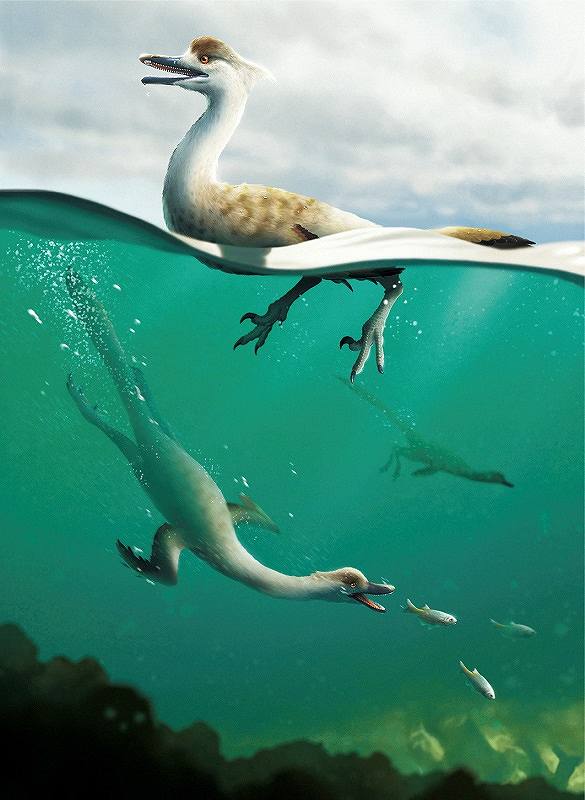
An image of the bird-like Cretaceous Period dinosaur Natovenator polydontus
16:12 JST, December 28, 2022
WASHINGTON (Reuters) — The expansive dinosaur group that included big predators such as T. rex also was populated by a number of oddballs, weirdos and outcasts. A newly described dinosaur from Mongolia — the size of a goose and looking a bit like one, too — fits that description.
The dinosaur, called Natovenator polydontus, lived about 72 million years ago during the Cretaceous Period and was built like a diving bird with a streamlined body while possessing a goose-like elongated neck and a long flattened snout with a mouth bearing more than 100 small teeth, scientists said on Dec. 1. It almost surely was covered in feathers, they added.
“Natovenator has many peculiar characteristics,” said paleontologist Yuong-Nam Lee of Seoul National University in South Korea, lead author of the research published in the journal Communications Biology.
While it was a cousin of speedy little predator Velociraptor, Natovenator was adapted to a semi-aquatic lifestyle in a freshwater ecosystem, perhaps floating on rivers and lakes, paddling with its front limbs, and using its flexible neck to catch fish and insects or diving underwater to capture its prey, the researchers said.
Its well-preserved remains — a skeleton about 70% complete — were unearthed in the Gobi Desert, which over the decades has been a treasure trove for dinosaur fossils.
Natovenator is part of the dinosaur group called theropods — sharing traits including bipedalism — best known for large meat-eaters including Tyrannosaurus, Tarbosaurus and Giganotosaurus. But the theropods, many of which were feathered, branched out in unusual directions with examples such as long-clawed ground sloth-like Therizinosaurus, ostrich-like Struthiomimus, termite-eating Mononykus and the entire bird lineage.
“The diversity of theropod dinosaurs by the end of the Cretaceous is totally amazing,” said University of Alberta paleontologist and study coauthor Philip Currie.
“I believe there will be more discoveries of fascinating, bizarre theropods in the future,” Lee added.
Not many of the dinosaurs called “non-avian” — in other words, not the birds — are known to have lived a semi-aquatic lifestyle. A close relative of Natovenator named Halszkaraptor, described in 2017, lived a similar lifestyle at roughly the same time in the same region. Both had a very bird-like appearance and were closely related to the bird lineage.
Natovenator measured about 45 centimeters long, with a skull about 7 centimeters long. Its front limbs appeared somewhat flattened, perhaps as an adaptation for paddling and swimming. The streamlining of its body is shown by ribs that point toward the tail, as in diving birds, an arrangement that reduces drag in the water and allows efficient swimming.
“Natovenator — which means ‘swimming thief’ — is an amazing little animal for several reasons. First it is small and delicate. When we found it, we were uncertain as to its identification because it looked more like a lizard or mammal skeleton than a dinosaur. Once it was prepared, we realized it was a theropod dinosaur, but what kind? Finally it made sense once Halszkaraptor was described,” Currie said.
“It is very specialized for living in an environment not typical for an animal related to Velociraptor and its other relatives. Most people think of dinosaurs as specialized land animals, not competing with crocodiles in the water,” Currie added.
There were various diving birds during the Cretaceous, including North America’s Hesperornis, which reached about 1.8 meters long, but none are known from the area Natovenator inhabited.
“More than 30 different lineages of tetrapods [terrestrial vertebrates] have independently invaded water ecosystems,” Lee said. “Why not dinosaurs?”
"Science & Nature" POPULAR ARTICLE
-

Genome Study Reveals Milestone in History of Cat Domestication
-

Big Leap in Quest to Get to Bottom of Climate Ice Mystery
-

Security Camera Footage Vulnerable to Outside Access; Investigation Finds 3,000 Pieces Exposed Online
-

Japan Set to Participate in EU’s R&D Framework, Aims to Boost Cooperation in Tech, Energy
-

Paws on Parade: Nairobi’s Dogs Dazzle at ‘Pawchella’
JN ACCESS RANKING
-

Tokyo Economic Security Forum to Hold Inaugural Meeting Amid Tense Global Environment
-

Keidanren Chairman Yoshinobu Tsutsui Visits Kashiwazaki-Kariwa Nuclear Power Plant; Inspects New Emergency Safety System
-

Imports of Rare Earths from China Facing Delays, May Be Caused by Deterioration of Japan-China Relations
-

University of Tokyo Professor Discusses Japanese Economic Security in Interview Ahead of Forum
-

Japan Pulls out of Vietnam Nuclear Project, Complicating Hanoi’s Power Plans























